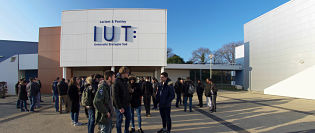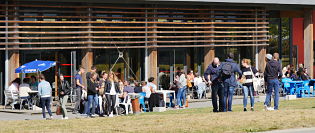Thematic of research
Thematic of research
Surface heterogeneity and surface-microbial cell interactions
The first scientific question relates to the link between surface heterogeneity and surface-microbial cell interactions when biofilm is formed
The focus here is on determining the link between surface heterogeneity and the interactions between a surface and microbial cells when biofilm is formed.
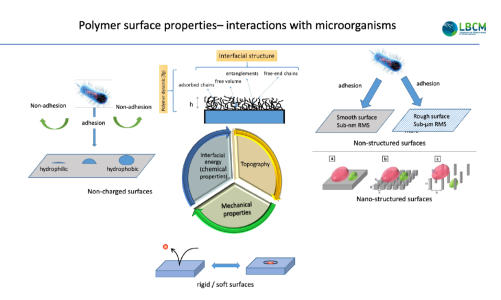
Our recent work has confirmed the relevance of amphiphilic surfaces in limiting bioadhesion in marine environments. These are surfaces that combine a hydrophobic matrix with low surface energy to reduce the surface/organism interaction forces, with a hydrophilic component that forms a hydrogel when immersed, creating a steric hindrance close to the surface.
The films investigated include a major hydrophobic component, typically polydimethylsiloxane (PDMS). The hydrophilic element, meanwhile, is composed of additives with PDMS-PEG (polyethylene glycol) units.
We are using these surfaces to investigate:
-
The impact of their heterogeneity on bioadhesion, using biosourced amphiphilic copolymers
-
The effect of hydrophilic repulsion. For this, we use hydrogels, controlling their mechanical and chemical properties using chitosan polysaccharides. The hydrogels are used to weave networks that may be quite dense or more sparse, with or without the addition of bacterial exopolysaccharides (EPSs) which are known to affect host/micro-organism interactions via toxicity-free mechanisms
-
How the physical and chemical characteristics of surfaces affect the variety of exoproducts of adhered microalgae.
References
Guennec A., Brelle L., Balnois E., Linossier I., Renard E., Langlois V., Faÿ F., Chen G. Q., Simon-Colin C., Vallée-Réhel K. 2021. Antifouling properties of amphiphilic poly(3-hydroxyalkanoate): an environmentally-friendly coating. Biofouling. DOI: 10.1080/08927014.2021.1981298 (IF 3.802)
Portier E., Azemar F., Bardeau J.F., Faÿ F., Réhel K., Lapinte V., Linossier I. 2021. Interest of poly(oxazoline) for the design of amphiphilic silicone coatings. Progress in Organic Coatings, 153: 106116. DOI: 10.1016 (IF 4.469)
Azemar F., Faÿ F., Réhel K., Linossier I. 2020. Ecofriendly silicon-poly(lactic acid) hybrid antifouling coatings. Progress in Organic Coatings. DOI 10.1016/j.porgcoat.2020.105841 (IF 4,469)
Holobionts, chemical mediation and bioprotection
The focus of the second scientific question is holobionts, chemical mediation and bioprotection. A holobiont is defined as a superorganism composed of a host organism and its microbiota, i.e. all the micro-organisms in their free-floating state or organised as a biofilm. If the existence of associated microbiota is now widely documented and accepted by the scientific community, the molecular interactions that control the microbiota and its role in macro-organism homeostasis are still unclear.
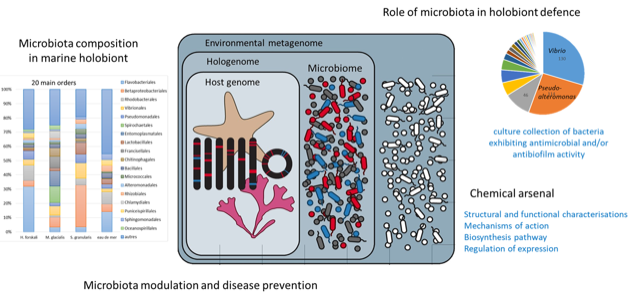
Our primary objectives are:
-
To inventory the microbiota associated with marine macro-organisms (holothuria, proliferating macro-algae, bacteria, etc.) using metabarcoding techniques.
-
To identify, from cultivable microbiota, bacterial strains with antimicrobial and/or antibiofilm activity directed against marine pathogenic bacteria
-
To examine and exploit the wide array of chemical mediators in the host and the microbiota via metabolomic analysis and investigation of antibiofilm, antibacterial, anti-oxidant and antiviral activity.
At the molecular level, our focus is on the structural characterisation of the original bioactive compounds produced, their mechanisms of action, their biosynthesis pathways and how their production is regulated. Various models for proliferating macro-algae (Ulva, Sargassum and Solieria), micro-algae and marine bacteria including the Pseudoalteromonas genus are being investigated.
References
Offret C., Rochard V., Laguerre H., Mounier J., Huchette S., Brillet B., Le chevalier P., Fleury Y. 2019. Protective Efficacy of a Pseudoalteromonas Strain in European Abalone, Haliotis tuberculata, Infected with Vibrio harveyi ORM4. Probiotics and Antimicrobial Proteins 11(1), 239-247.
Jouault A., Gobet A., Simon M., Portier E., Perennou M., Corre E., Gaillard F., Vallenet D., Michel G., Fleury Y., Bazire A. and Dufour A. 2020. Alterocin, an antibiofilm protein secreted by Pseudoalteromonas sp. 3J6. Applied Environmental Microbiology. 86(23). (IF 3.96).
Abdul Malik S.A., Bedoux G., Robledo D., Garcia Maldonado J.Q., Freile-Pelegrín Y., Bourgougnon N. 2020. Chemical defence by allelopathic active metabolites of Halymenia floresii (Rhodophyta) against biofouling. Journal of Applied Phycology, 10.1007/s10811-020-02094-4.
Doghri I., Brian-Jaisson F., Graber M., Bazire A., Dufour A., Bellon-fontaine M. N., Herry J. M., Ferro A. C., Sopena V., Lanneluc I., and Sable S. 2020. Antibiofilm activity in the culture supernatant of a marine Peudomonas sp. Bacterium. Microbiology 166, 239-252.
Link between biofilm and bacterial virulence
The third scientific question examines the link between biofilm and bacterial virulence. The pathogenic nature of bacteria is generally declared based on their ability to produce acute virulence (toxin, protease or haemolysin secretion) or chronic virulence (biofilm formation). Two genera of pathogenic bacteria in particular are being investigated: the Vibrio genus, a pathogen in marine organisms, and the Pseudomonas genus, an animal and human pathogen. Our aim is to develop a better understanding of their mechanisms of acute and chronic virulence and to use metabolites of marine origin to protect against them.
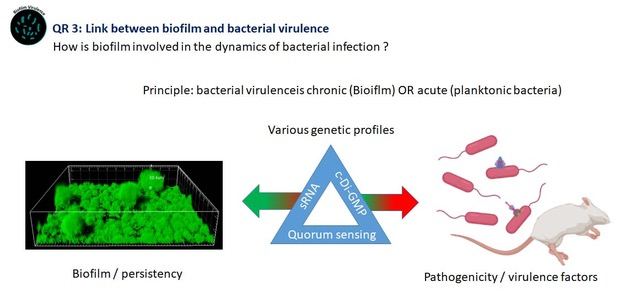
Our main aims
-
Examine the formation dynamics, structure and composition of pathogenic bacteria biofilms under different conditions (static/dynamic), primarily using swept field laser confocal microscopy
-
Develop models for investigating virulence on multiple scales: molecular, cellular, tissue, organism
-
Identify the genes associated with acute and chronic virulence mechanisms via site-directed mutagenesis techniques and techniques for investigating gene expression
-
Determine metabolite efficacy as regards their antibiofilm, antivirulence and anti-QS activity, and identify their mechanisms of action and target molecules
There is an obvious fundamental benefit to understanding the mechanisms of acute and chronic virulence and identifying the mechanisms of action of active metabolites. It could also help us to suggest alternatives to the use of antibiotics in human and animal health.
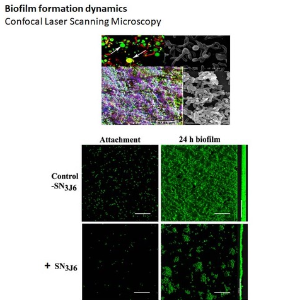
References
Lesouhaitier O., Clamens T., Rosay T., Desriac F., Louis M., Rodrigues S., Gannesen A., Plakunov V.K., Bouffartigues E., Tahrioui A., Bazire A., Dufour A., Cornelis P., Chevalier S., Feuilloley M.G.J. 2019. Host peptidic hormones affecting bacterial biofilm formation and virulence. Journal of Innate Immunity 11, 227–241.
Morot A., El Fekih S., Bidault A., Le Ferrand A., Jouault A., Kavousi J., Bazire A., Pichereau V., Dufour A., Paillard C., Delavat F. 2021. Virulence of Vibrio harveyi ORM4 towards the European abalone Haliotis tuberculata involves both quorum sensing and a type III secretion system. Environmental microbiology. 23(9), 5273-5288 (IF 5,49).
Biotechnology value creation: Global approach to biotechnology value creation
Selection and development of probiotics for use in aquaculture
We showed that the marine bacterium Pseudoalteromonas 3J6 prevents in vitro formation of biofilms by Vibrio tapetis, which is responsible for brown ring disease in clams. The exoproducts of Pseudoalteromonas 3J6 inhibit adhesion of V. tapetis to glass and the formation of biofilm, creating the potential for an antibiofilm strategy. This research was supplemented by a transcriptomic study (RNA sequencing) of V. tapetis biofilms. The results are being analysed and will be used to identify genes of interest for investigating links between biofilm and virulence.
The effects of Pseudoalteromonas strain hCg-6 were assessed in Whiteleg shrimps, Litopeanus vannamei (SATT Ouest Valorisation maturation programme (DV 2029), €235k) and in European green ormers, Haliotis tuberculata (CBB Capbiotek programme (Haliobiote II) €25k). The work showed that the hCg-6 strain is not harmful to animals. A significant protective effect was shown in animals infected with Vibrio sp, enabling the Pseudoalteromonas hCg-6 strain to be qualified as a probiotic in aquaculture. SATT Ouest Valorisation has begun the transfer of this technology to various companies in the animal nutrition probiotics sector.
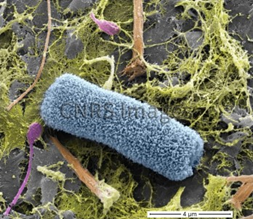
References
Cuny H., Offret C., Boukerb A M, Parizadeh L., Lesouhaitier O, Le Chevalier P., Jégou C., Bazire A., Brillet B., Fleury Y. 2021. Pseudoalteromonas ostreae sp. nov., a new bacterial specie harbored by the flat oyster Ostrea edulis. International Journal of Systematic and Evolutionary Microbiology. DOI: 10.1099/ijsem.0.005070. (IF 2.825)
Rodrigues, C. Paillard, A. Dufour, A. Bazire. 2015. Antibiofilm activity of the marine bacterium Pseudoalteromonas sp. 3J6 against Vibrio tapetis, the causative agent of Brown Ring Disease. Probiotics and Antimicrobial Proteins 7, 45-51. (IF 4.60)
Rodrigues, C. Paillard, G. Le Pennec, A. Dufour, A. Bazire. 2015. Vibrio tapetis, the causative agent of Brown Ring Disease, forms biofilms with spherical components. Frontiers in Microbiology 6, 1384 (IF 5,64).
Environmentally responsible extraction and purification processes for identifying new defence molecules isolated from marine organisms
Certain sessile marine species (macroalgae, bryozoans, nudibranchs, etc.) with no effective physical means of defence are exposed to biotic and abiotic stresses. These species are equipped with a defence molecule production system that helps them adapt to this environment, combating predators effectively and controlling microorganism colonisation.
The low molecule concentration and the complexity of the metabolite mixtures produced by these organisms make the use of high performance extraction and analytical chemistry methods and techniques a necessity. We have developed new eco-responsible, environmentally friendly processes for isolating and characterising these protagonist metabolites that are also heedful of societal demands.
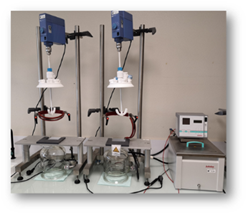
-
Enzyme-Assisted Extraction (EAE): antiviral oligo- and polysaccharides, glycoproteins and immunostimulatory, anti-inflammatory, anti-oxidant and antibacterial molecules in Solieria chordalis(Rhodophyta) and Ulva sp. (Chlorophyta), phenolic compounds in Sargassum muticum (Ochrophyta)
-
Microwave-Assisted Extraction (MAE): antiviral oligo- and polysaccharides in Solieria chordalis (Rhodophyta)
-
Supercritical CO2 extraction of lipid compounds from Solieria chordalis and Sargassum muticum that are valued in the cosmetics industry
-
Use of centrifugal partition chromatography (CPC) to separate photoprotective (anti-oxidant, anti-UV) compounds belonging to various families, including mycosporine-like amino acids inSolieria chordalis
References
Lang M., Montjarret A., Duteil E., Bedoux G. 2021. Cinnamomum cassia and Syzygium aromaticum essential oils reduce the colonization of Salmonella Typhimurium, in an in vivo infection model using Caenorhabditis elegans. Molecules (26), 5598. DOI: 10.3390/ molecules26185598. (IF 4.41)
Peñuela A., Bourgougnon N., Bedoux G., Robledo D., Madera-Santana T., Freile-Pelegrín Y. 2021. Anti-Herpes simplex virus (HSV-1) activity and antioxidant capacity of carrageenan-rich enzymatic extracts from Solieria filiformis (Gigartinales, Rhodophyta). International Journal of Biological Macromolecules, 168, 322-330 DOI: 10.1016/j.ijbiomac.2020.12.064. (IF 6.95)
Le Loeuff J., Boy V., Morançais P., Bourgougnon N., Lanoisellé J.L. 2021. Mathematical modeling of air impingement drying of brown alga Sargassum muticum. Chemical Engineering & Technology, 44 (11), 1–10 DOI: 10.1002/ceat.202100244. (IF 1.54)
Development of amphiphilic anti-adhesive surfaces
Biocide-free anti-adhesive systems were synthesised and investigated. The structures selected were based on hydrophobic polydimethylsiloxane (PDMS) in combination with a PEG (polyethylene glycol) hydrophilic polymer. The combination of these two polymers makes the surface of the coating amphiphilic, enhancing its antifouling efficacy. All the characteristics of the copolymer (molar mass, nature of functionalisation, crosslinking mechanism, composition) are parameters that will be investigated with the aim of producing a film with mechanical, physical and chemical properties commensurate with the efficacy of the coating.
References
Guennec A., Brelle L., Balnois E., Linossier I., Renard E., Langlois V., Faÿ F., Chen G. Q., Simon-Colin C., Vallée-Réhel K. 2021. Antifouling properties of amphiphilic poly(3-hydroxyalkanoate): an environmentally-friendly coating. Biofouling in press. DOI: 10.1080/08927014.2021.1981298 (IF 3.802)
Gillet, F. Azemar, F. Fay, K. Réhel, I. Linossier. Non-Leachable Hydrophilic Additives for Amphiphilic Coatings. Polymers, 10(4):445, (2018) (IF 3,509)
Faÿ, M. Gouessan, I. Linossier, K. Réhel.Additives for Efficient Biodegradable Antifouling Paints. International Journal of Molecular Science, 20 (2), 361 (2019) (IF 3,687)








